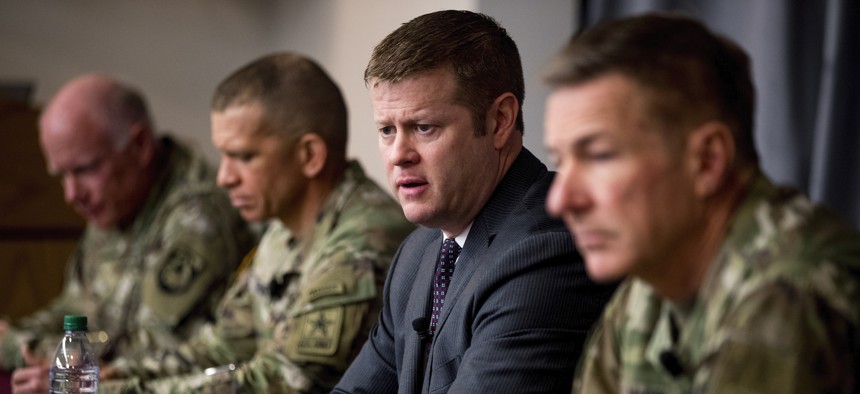
Secretary of the Army Ryan McCarthy, center, accompanied by Col. Darrin Cox, left, Sgt. Maj. Michael Grinston, second from left, and Gen. James McConville, Chief of Staff of the Army, speaks at a news conference at U.S. Army Medical Research and Developme AP Images
Army Was Reviewing More Than Confederate Base Names, Officials Reveal
Among the potential friction points eyed were Army National Guard units with nicknames honoring Confederate leaders.
When President Donald Trump told U.S. Army leaders in June not to remove Confederate names from bases, he also effectively halted an Army effort to create and implement a policy on divisiveness in the ranks far broader than a simple ban on the display of the Stars and Bars on military property.
Rather than targeting just the flag or the base names, the idea was to take a commission-style approach that would look at anything that might be divisive and address not only the symbol, but the cultural forces behind it. The expectation and hope was that as the review progressed, other long-buried issues would become apparent.
The Army, as the oldest and largest of the service branches, has become a focal point of the bitter national debate over Confederate symbology in the military, in part because it is the only service branch with 10 major bases named for Confederate generals and one colonel.
Among the potential friction points that arose during brainstorming sessions were Army National Guard units with nicknames honoring Confederate leaders, according to two defense officials. There are at least two: The Kentucky Army National Guard’s 1st Battalion, 623rd Field Artillery is nicknamed “Morgan’s Men” after Gen. John Hunt Morgan, a Confederate general famous for an 1863 raid into a handful of border states that was supposed to draw Union forces away from the Vicksburg and Gettysburg Campaigns. (The raid was ultimately deemed a failure.) In Virginia, the storied 29th Infantry regiment known as “the Blue and Gray Division” is based at Fort Belvoir, outside of Washington, D.C. — an homage to the gray uniforms of the Confederacy.
But after an Army spokesman publicly revealed that the department was open to changing the base names, Trump emphatically forbade it in a tweet and threatened to veto the annual defense policy bill over a provision kickstarting the process.
“These Monumental and very Powerful Bases have become part of a Great American Heritage, and a history of Winning, Victory, and Freedom,” Trump tweeted on June 10. “The United States of America trained and deployed our HEROES on these Hallowed Grounds, and won two World Wars. Therefore, my Administration will not even consider the renaming of these Magnificent and Fabled Military Installations.”
Since then, the Army’s nascent reform process has ground to a halt, frustrating department leaders. One defense official said the effort effectively was being held up by Defense Secretary Mark Esper, caught between Trump and his service secretaries. Trump has unequivocally sided against attempts to reshape how America treats public symbols of the Confederacy to reflect its history of slavery and war against the United States — and Esper is already reported to be on thin ice with the president after he broke with Trump’s desire to use active duty forces to quell protests over the killing of George Floyd.
Esper’s office is circulating a draft memo banning the display of the Confederate flag across the Defense Department. Another defense official disputed the notion that there was any frustration with the defense secretary’s office, but acknowledged that the Army’s broader effort has stalled amid the public fight over the base renaming. A spokesman for Esper declined to comment on the record.
With an eye on the 2020 election, Trump has launched a controversial campaign against protesters pushing for the removal of Confederate monuments and implicitly supported the display of the Confederate flag at NASCAR races.
“Our nation is witnessing a merciless campaign to wipe out our history, defame our heroes, erase our values, and indoctrinate our children,” Trump said, in a July 3 speech at Mt. Rushmore. Trump boasted that federal agents arrested protestors who attempted to tear down the statue of President Andrew Jackson in Lafayette Park, adjacent to the White House. The president did not mention the Confederacy, Army base names, or the military efforts to ban Confederate flag displays, but chastised Democrats and liberals for attempting “to tear down every statue, symbol, and memory of our national heritage.” He instead criticized protestors for targeting “monuments to George Washington, Abraham Lincoln, Ulysses S. Grant, abolitionists, and many others.”
Proponents of changing Army base names and removing other Confederate hagiography say that the benefits would be symbolic and practical. For some service members, bases named after men who fought to leave the United States and continue to enslave Black Americans are monuments venerating treason and racism. Practically, those who want the base names changed say, the names damage recruitment efforts — particularly among communities of color and from educational backgrounds in science and technology that the military needs for modernization efforts, where support for symbols of the Confederacy is much lower than it is in the rural South. Southern states currently send an overwhelmingly higher percentage of their eligible population in new recruits than other U.S. states.
U.S. troops have been permitted to carry Confederate symbols during military action since at least World War II. President Harry Truman in 1948 signed legislation from Sen. Millard Tydings, D-Md., allowing Army units to carry Confederate battle streamers with regimental flags overseas.
“The sons of those who fought on the southern side in the Civil War, in memory of the battles in which their fathers fought, at least should have the right to carry these streams as a matter of maintaining military morale,” Tydings said on the Senate floor, introducing the bill in 1943.
Also in 1945, Truman signed Executive Order 9981, committing the United States to the desegregation of its military. The U.S. military is now one of the most diverse institutions in America. Roughly 18 percent of active-duty service members are Hispanic and roughly 13 percent are Black or African Americans.
The Navy and the Marine Corps have already moved to ban the display of the Confederate battle flag from public and shared spaces — including on things like T-shirts, bumper stickers, and coffee mugs in individual work spaces. Announcing the change in late April, Commandant of the Marine Corps Gen. David Berger said the flag “has the power to inflame feelings of division.” While acknowledging that to some, the flag is a “symbol of heritage or regional pride,” Berger wrote that “I am also mindful of the feelings of pain and rejection of those who inherited the cultural memory and present effects of the scourge of slavery in our country.”
“I am focused solely on building a uniquely capable warfighting team whose members come from all walks of life and must learn to operate side-by-side,” he said.
Prominent retired military leaders have also spoken out in favor of removing Confederate paraphernalia, including changing base names.
“These bases are, after all, federal installations, home to soldiers who swear an oath to support and defend the Constitution of the United States,” retired Army general and former CIA director David Patraeus wrote in The Atlantic. “The irony of training at bases named for those who took up arms against the United States, and for the right to enslave others, is inescapable to anyone paying attention.”
Patraeus added that Gen. Braxton Bragg — the namesake of Fort Bragg, in North Carolina, home of the fabled 82nd Airborne Division and where U.S. Army special operations forces are based — ”left a great deal to be desired as a military leader” and “would probably have been consigned to historical obscurity” had he “not been elevated by the effort to memorialize the ‘Lost Cause.’”
Petraeaus also called for West Point to rethink how it remembers Gen. Robert E. Lee, the storied alum and commander of the Confederate Army who is memorialized at the school, in the U.S. Capitol, and elsewhere. Two years ago, Gen. Stan McChrystal, who was top U.S. and NATO commander of the Afghanistan War, publicly announced that he had thrown away his Lee portrait, in a similar essay calling for change.
Lee famously did not want symbols of the Confederacy to endure. In 1869, he declined an invitation to the unveiling of granite memorials to both armies at Gettysburg.
“I think it wiser, moreover,” Lee wrote, “not to keep open the sores of war but to follow the examples of those nations who endeavored to obliterate the marks of civil strife, to commit to oblivion the feelings engendered.”
In Congress, committees led by Republicans and Democrats have moved to force the administration to rename military bases. Both the House and Senate Armed Services Committees included amendments in their versions of the annual defense policy bill towards that end; the Senate version requires that they be renamed within three years, while the House version demands it within one. (Some GOP senators hope to strip the amendment out of the final version of the bill, but that effort from Sen. Josh Hawley, R-Mo., appears unlikely to get a vote.) Meanwhile, a pair of House spending bills would block funding for military construction projects at bases named after Confederate leaders unless a renaming process is underway, and allocate $1 million to the Army to rename the bases and any base street names.
Some Republicans have watched with alarm as Trump has leaned into racial flashpoints in recent weeks. Two weeks ago, he retweeted a video of a Trump supporter shouting “white power” at counter-protestors at a retirement community. After hours of public outcry, he deleted the tweet and his spokesperson claimed the president had not heard the audio of the tweet. On Monday, Trump demanded that Black NASCAR driver and activist Bubba Wallace apologize for the controversy over an alleged noose that was found in his garage in Talladega — it was NASCAR officials who discovered the noose-shaped garage pull, not Wallace — calling it a “hoax.” In the same tweet, Trump insisted that NASCAR’s decision to ban the display of the Confederate flag was to blame for stock car racing’s “lowest ratings ever.”
Sen. Lindsey Graham, R-S.C., a staunch supporter of Trump, pushed back on both assertions in a Fox News radio interview Monday. NASCAR “is trying to grow the sport,” Graham said. “And I’ve lived in South Carolina all my life, and if you’re in business, the Confederate flag is not a good way to grow your business.”




